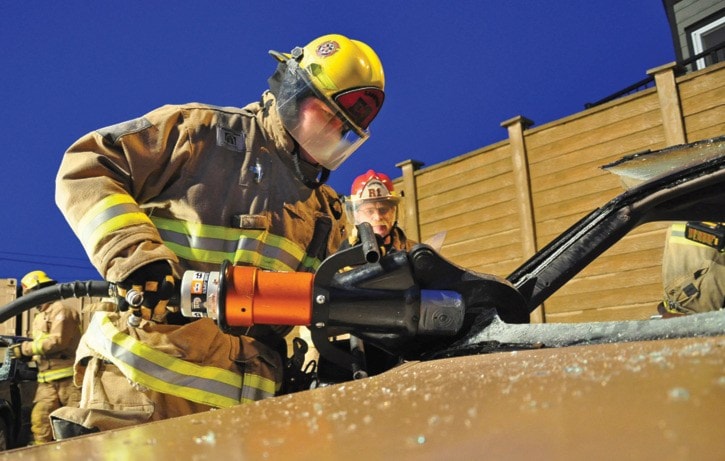The shrill roar of metal against metal pierces the air as a Langford volunteer firefighter tears into a car with an air chisel.
He jackhammers into the trunk, while a nearby colleague pries the jaws of life into a door hinge. The commander shouts instructions over the din of the generator and hum of hydraulic tools.
Thursday night training has been a staple of Langford firefighters since 1947, and in this case at Station No. 2 on Happy Valley Road, it is now in the midst of a residential neighbourhood.
Tearing apart cars beside someone’s house isn’t ideal, fire officers admit.
“We are about seven feet from the residence,” says assistant chief Scott Davidson. “That homeowner is great, but the generators are running, the hydraulics run for two hours. It can be disruptive noise pollution.”
Indeed, Station No. 2 is a noisy wrecking ground. Volunteers smash car windows, slice frames and learn to wrench doors open using leverage from a pulley and chains.
“Learning how to open a car door that is smashed in, you’ve got to get the tools into your hands,” added assistant chief Geoff Spriggs. “But we want to be considerate of our neighbours. We need to do this without bothering people.”
With noisy but necessary training rubbing up against growing neighbourhoods, Langford Fire Rescue is launching an effort to build a permanent training facility. Davidson made the pitch to Langford’s protective services committee earlier this month — if the City provides or buys land, firefighters will fund and build the training stations.
“Volunteers love to do projects in the community that give back. Providing a quality training centre will give back to the community in spades,” Davidson told the committee.
“Realistic training is key to retention and satisfaction. Ultimately it improves firefighter proficiency,” Davidson says.
“Retention can’t be overstated. Close to half our firefighters have less than five years experience,” said firefighter Jean-Paul Thuot, a citizen rep on the protective services committee. “Getting over the five year mark the numbers drop quickly. There are only two guys with 20 years of experience.”
Coun. Lanny Seaton said Langford is looking at a piece of City-owned land in an industrial area as a training site, but couldn’t yet go into details. “We’ve identified a place, but we’ve got to make sure,” he said. “But I think it would work really well.”
Seaton volunteered as a Langford firefighter for 10 years in the 1970s. Similar to now, he trained in different parts of the city, but was able to have live-fire training on houses up for demolition and on cars in auto wrecking yards.
“There’s no auto wreckers around anymore,” Seaton says. “And you can’t put a ladder up the side of a condo.”
These days, the composite force of 55 volunteers and eight paid officers split training between limited spaces at the three fire halls, parking lots around the city and occasionally within houses slated for redevelopment.
Langford firefighters can get the feel of a smoke filled building in a tower at Station No. 1 and auto-extrication training at No. 2, but for live fire certification they go to Nanaimo or the Mainland. Otter Point uses three sea containers as a burn building, which Davison says is “ good for recruits” but isn’t challenging for seasoned firefighters.
“It’s not as realistic as a fire training facility could be,” Davidson says, referring to what is available at Langford fire stations. “We’re still pulling hoses around parking lots. It’s starting to disrupt commerce.”
Langford Fire Chief Bob Beckett said a permanent, centralized training facility is critical to build and maintain a majority volunteer force.
“With a career or volunteer-composite model, more than 90 per cent of the time is spent training, getting ready for the game,” Beckett says. “Volunteers have a busy schedule at work and at home, so to commit to training, they’ve got to enjoy training.”
